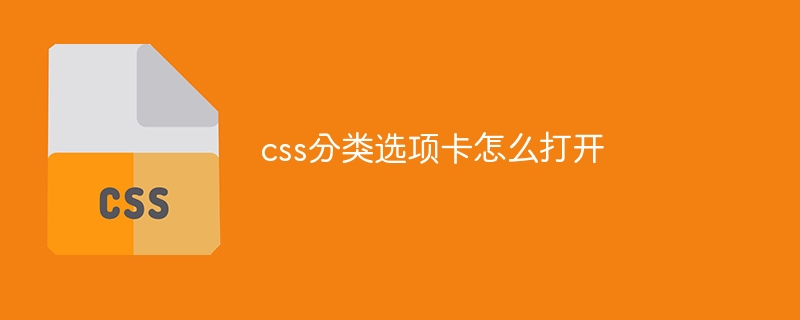How to open css category tab
CSS Classified tabs can display classified content, which can be achieved through the following steps: create an HTML container, contain tab buttons and content, and set its ID attribute; set the CSS style of the tab and content; use JavaScript to listen Tab button click event, hides all tab content and displays the tab content corresponding to the clicked button.

CSS category tab opening method
CSS category tab is a method used to organize and display content. way, which allows users to switch between different categories of content by clicking on tabs. To open CSS category tabs, you need to follow these steps:
HTML Structure
- Create a container element in HTML that contains the tab bar and tab content .
- Create a
<button>or<a>element for each tab and set itsidattribute. - Create a
<div>element for each tab content and set itsidattribute.
The following is a sample HTML structure:
<div class="tabs"> <button id="tab1">选项卡 1</button> <button id="tab2">选项卡 2</button> <div id="content1">内容 1</div> <div id="content2">内容 2</div> </div>
CSS style
- Set the style of the tab bar, including background color, Font size and alignment.
- Set the style of the tab button, including the style of the inactive and activated states.
- Set the style of the tab content, including background color, padding and border.
Here are sample CSS styles:
.tabs {
display: flex;
background-color: #f1f1f1;
padding: 10px;
}
.tabs button {
padding: 10px 20px;
background-color: #ccc;
border: none;
cursor: pointer;
}
.tabs button.active {
background-color: #f1f1f1;
}
.tabs div {
display: none;
padding: 20px;
}
.tabs div.active {
display: block;
}JavaScript Event Handling
- Use JavaScript to listen for the click event of the tab button.
- Hide all tab content when the user clicks the button.
- Display the content of the tab corresponding to the clicked button.
The following is sample JavaScript event handling:
const tabs = document.querySelector('.tabs');
tabs.addEventListener('click', (e) => {
if (e.target.tagName === 'BUTTON') {
const tabId = e.target.id;
const contentId = tabId.replace('tab', 'content');
const buttons = tabs.querySelectorAll('button');
buttons.forEach(btn => btn.classList.remove('active'));
e.target.classList.add('active');
const contents = tabs.querySelectorAll('div');
contents.forEach(content => content.classList.remove('active'));
const content = tabs.querySelector(`#${contentId}`);
content.classList.add('active');
}
});The above is the detailed content of How to open css category tab. For more information, please follow other related articles on the PHP Chinese website!

Hot AI Tools

Undresser.AI Undress
AI-powered app for creating realistic nude photos

AI Clothes Remover
Online AI tool for removing clothes from photos.

Undress AI Tool
Undress images for free

Clothoff.io
AI clothes remover

Video Face Swap
Swap faces in any video effortlessly with our completely free AI face swap tool!

Hot Article

Hot Tools

Notepad++7.3.1
Easy-to-use and free code editor

SublimeText3 Chinese version
Chinese version, very easy to use

Zend Studio 13.0.1
Powerful PHP integrated development environment

Dreamweaver CS6
Visual web development tools

SublimeText3 Mac version
God-level code editing software (SublimeText3)

Hot Topics
 1660
1660
 14
14
 1416
1416
 52
52
 1310
1310
 25
25
 1260
1260
 29
29
 1233
1233
 24
24
 How to use bootstrap in vue
Apr 07, 2025 pm 11:33 PM
How to use bootstrap in vue
Apr 07, 2025 pm 11:33 PM
Using Bootstrap in Vue.js is divided into five steps: Install Bootstrap. Import Bootstrap in main.js. Use the Bootstrap component directly in the template. Optional: Custom style. Optional: Use plug-ins.
 Understanding HTML, CSS, and JavaScript: A Beginner's Guide
Apr 12, 2025 am 12:02 AM
Understanding HTML, CSS, and JavaScript: A Beginner's Guide
Apr 12, 2025 am 12:02 AM
WebdevelopmentreliesonHTML,CSS,andJavaScript:1)HTMLstructurescontent,2)CSSstylesit,and3)JavaScriptaddsinteractivity,formingthebasisofmodernwebexperiences.
 The Roles of HTML, CSS, and JavaScript: Core Responsibilities
Apr 08, 2025 pm 07:05 PM
The Roles of HTML, CSS, and JavaScript: Core Responsibilities
Apr 08, 2025 pm 07:05 PM
HTML defines the web structure, CSS is responsible for style and layout, and JavaScript gives dynamic interaction. The three perform their duties in web development and jointly build a colorful website.
 How to add functions to buttons for vue
Apr 08, 2025 am 08:51 AM
How to add functions to buttons for vue
Apr 08, 2025 am 08:51 AM
You can add a function to the Vue button by binding the button in the HTML template to a method. Define the method and write function logic in the Vue instance.
 How to insert pictures on bootstrap
Apr 07, 2025 pm 03:30 PM
How to insert pictures on bootstrap
Apr 07, 2025 pm 03:30 PM
There are several ways to insert images in Bootstrap: insert images directly, using the HTML img tag. With the Bootstrap image component, you can provide responsive images and more styles. Set the image size, use the img-fluid class to make the image adaptable. Set the border, using the img-bordered class. Set the rounded corners and use the img-rounded class. Set the shadow, use the shadow class. Resize and position the image, using CSS style. Using the background image, use the background-image CSS property.
 How to write split lines on bootstrap
Apr 07, 2025 pm 03:12 PM
How to write split lines on bootstrap
Apr 07, 2025 pm 03:12 PM
There are two ways to create a Bootstrap split line: using the tag, which creates a horizontal split line. Use the CSS border property to create custom style split lines.
 How to set up the framework for bootstrap
Apr 07, 2025 pm 03:27 PM
How to set up the framework for bootstrap
Apr 07, 2025 pm 03:27 PM
To set up the Bootstrap framework, you need to follow these steps: 1. Reference the Bootstrap file via CDN; 2. Download and host the file on your own server; 3. Include the Bootstrap file in HTML; 4. Compile Sass/Less as needed; 5. Import a custom file (optional). Once setup is complete, you can use Bootstrap's grid systems, components, and styles to create responsive websites and applications.
 How to resize bootstrap
Apr 07, 2025 pm 03:18 PM
How to resize bootstrap
Apr 07, 2025 pm 03:18 PM
To adjust the size of elements in Bootstrap, you can use the dimension class, which includes: adjusting width: .col-, .w-, .mw-adjust height: .h-, .min-h-, .max-h-




